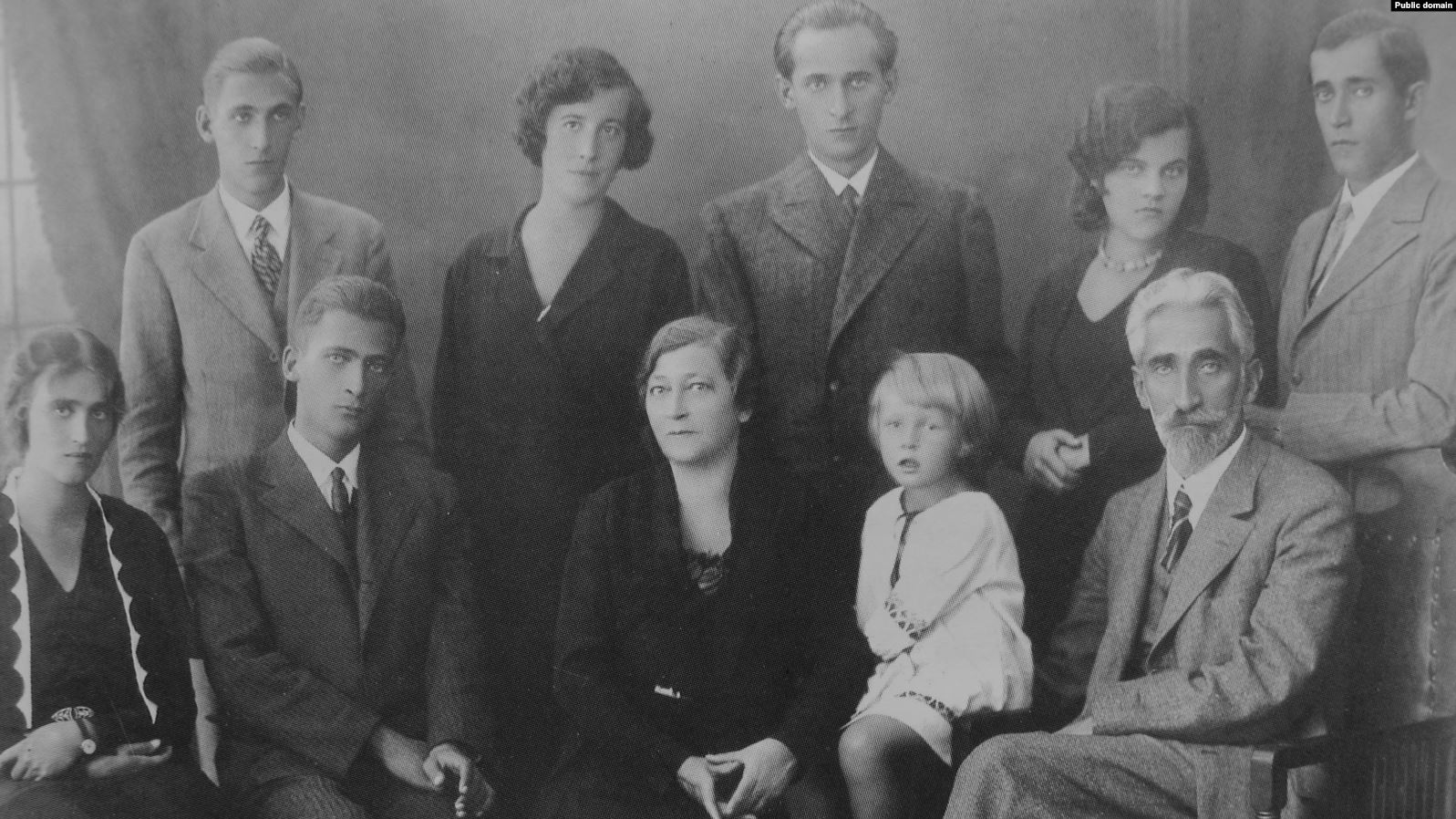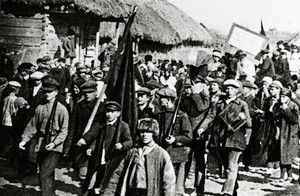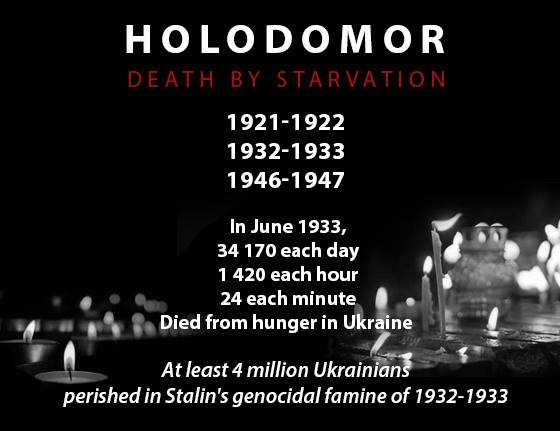Photo of the Krushelnytsky-Levytsky family
Sitting (from left to right):
Volodymyra Krushelnytska - dermatologist, publicist, editor, public and cultural figure, arrested on December 12, 1934, exiled to Solovki penal colony for “illegal counter-revolutionary activities”, and executed by soviet authorities in Leningrad Region on December 8, 1937
Taras Krushelnytsky - writer, translator, active member of Plast scouting organization, executed by soviet authorities with his brother Ivan in the cellars of the Zhovtnevy Palace in Kyiv on December 17, 1934
Mariya Krushelnytska (née Sloboda, mother) - actress, writer, social activist; after the arrest of her family members and the death of her sons Ivan and Taras, Mariya fell seriously ill and died from cardiac failure in Kharkiv hospital on August 28, 1935
Larysa Krushelnytska
, daughter of Halyna and Ivan - prominent archaeologist, scholar and librarian, rescued from exile and death by her mother, lived and worked in Lviv, died on November 12, 2017
Antin Krushelnytsky (father) - writer, literary critic and scholar, pedagogue, UNR Minister of Education, executed by the soviet authorities on November 3, 1937 in Sandarmokh forest, Karelia Republic, RF
Standing (from left to right):
Ostap Krushelnytsky - cinema researcher, journalist, executed by the soviet authorities on November 3, 1937 in Sandarmokh forest, Karelia Republic, RF
Halyna Levytska Krushelnytska (Ivan’s wife) - prominent pianist and teacher, dean of the Piano Faculty of the Lviv Conservatory, escaped from Stalinist persecution, reunited with her daughter Larysa, died on July 13, 1949 in Lviv
Ivan Krushelnytsky - poet, playwright, graphic artist, art and literary critic, executed by soviet authorities together with his brother Taras in the cellars of the Zhovtnevy Palace in Kyiv on December 17, 1934
Natalia (Bohdan’s wife)
Bohdan
- economist, teacher, executed by the soviet authorities together with his brother Ostap and father Antin on November 3, 1937 in Sandarmokh forest, Karelia Republic, RF
The Great Terror
The mass extermination of the Ukrainian intelligentsia started in May 1933. The campaign lasted from 1934 to 1940, reaching a peak during the Great Purge of 1937-1938. Overall, 223 writers and intellectuals were subjected to persecution, arrest, exile, imprisonment and execution. The culmination of the actions of the Soviet repressive regime was the mass executions of so-called “counter-revolutionaries” committed on the eve of the 20th anniversary of the October revolution. Over 300 members of Ukraine’s Executed Renaissance were shot between October 27 and November 4 at Sandarmokh, a massive killing field in Karelia Republic (northwest Russia).
The tragic destiny of the Krushelnytsky-Levytsky family was described by Larysa Krushelnytska, daughter of Halyna and Ivan Krushelnytski, prominent archeologist and professor, who passed away in Lviv on November 12, 2017.
“Why did your grandfather Antin decide to move from Lviv (then Poland) to Soviet Kharkiv in 1932-1934, even though millions of Ukrainians had died at the hands of the soviet regime during the Holodomor in 1933?” a Radio Liberty reporter asked Larysa Krushalnytska in an interview in 2012. Her answer was laconic: “Grandpa was obsessed with working for the good of Ukraine!”
In another interview, Larysa Krushelnytska comments further on her grandfather’s fatal decision to move to Soviet Ukraine:
“I believe that my grandfather Antin’s decision to move to Kharkiv testifies to his ignorance about the scale of the Holodomor tragedy .
“Well, what about hunger!” I remember him saying, “We Ukrainians have lived through more than one famine; it won’t last forever...”
Yes, it’s true… Ukrainians have survived other famines and hardships. However, only a person who has survived a real famine can transmit this feeling of absolute hunger. Moreover, at that time, it was truly impossible for us, living in Galicia, to believe in the reality of an artificial famine organized to wipe out everyone, even young children.”

Antin Krushelnytsky’s tragic mistake
In her book Рубали ліс (They destroyed the forest), Larysa Krushelnytska analyzes her grandfather’s decision to leave Lviv (then under Polish rule) for Soviet Ukraine. The Galician intellectual elite placed great hopes in “Велика Україна” (Greater Ukraine). Antin Krushelnytsky corresponded with many Ukrainian cultural figures, writers and scientists that worked in Kharkiv. Moreover, after the First World War, an atmosphere of intolerance and daily persecution by the Polish administration prevailed throughout Western Ukraine. Antin Krushelnytsky and his children were constantly harassed and accused of inconsistency of views. The Krushelnytsky family was faced with a choice: either immigration to Canada or departure to Soviet Ukraine. In May 1934, they left for Kharkiv.
The Krushelnytsky family members had hardly settled in their apartments, when the NKVD came knocking on their doors. Ivan and Taras were taken first. Then came the turn of Antin Krushelnytsky, followed by Bohdan, Ostap and Volodymyra.
Together with a group of Kharkiv intellectuals (28 people), 26-year-old Taras and 29-year-old Ivan Krushelnytsky were “put on trial” and hurriedly executed in the cellars of the Zhovtnevy Palace in Kyiv on December 17, 1934.
Their mother, Mariya Sloboda-Krushelnytska, was overwhelmed with grief and died in Kharkiv in 1935.
Other members of the Krushelnytsky family - Antin, Bohdan, Ostap and Volodymyra – were exiled to the Solovki gulag. Antin, Bohdan, Ostap were shot together with other Ukrainian intellectuals at Sandarmokh, Karelia Republic, RF on November 3, 1937. Volodymyra was executed in Leningrad Region on December 8, 1937.
Halyna, who had remained in Lviv due to illness, searched for her young daughter everywhere, and finally, with the assistance of the widow of Polish Prime Minister Józef Pilsudski and the Soviet Red Cross in Geneva, found her in Kursk, Russia. Mother and daughter returned to Lviv, where they resided until their death, Halyna in 1949 and Larysa in 2017.
In 2005, when Larysa Krushelnytska’s book - Рубали ліс (They destroyed the forest) - was first released, prominent Ukrainian poet and writer Lina Kostenko wrote the following prophetic words:
“I feel that posthumous masks and crosses - known and unknown symbolic graves – hang over us all, over all of Ukraine. These are, in fact, posthumous masks of so many Ukrainians who loved their country, who lived and died for their Motherland.
These are the posthumous masks and crosses that we have become accustomed to seeing as something commonplace in our history. They have become part of our interior. And, we don’t even think about the essence of this horror… because behind each posthumous mask was a real person who wanted to live life to the fullest... ”.





